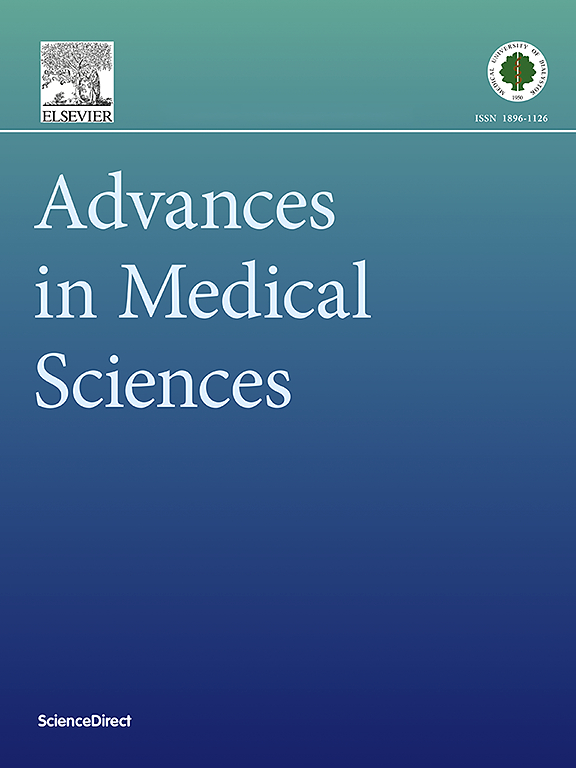三甲胺n -氧化物作为COVID-19疾病患者死亡率的潜在预后生物标志物
IF 2.6
4区 医学
Q3 MEDICINE, RESEARCH & EXPERIMENTAL
引用次数: 0
摘要
目的:三甲胺n -氧化物(TMAO)被认为是炎症和心血管疾病的生物标志物,这些疾病被确定为2019冠状病毒病(COVID-19)重症病例的危险因素。我们的主要目的是评估血清TMAO水平在预测covid -19相关死亡率方面的预后潜力。第二个目的是检查各种生化参数的潜力,特别是与炎症或血栓相关的生化参数,作为死亡率的预测因子。患者和方法:在这项前瞻性单中心研究中,根据住院死亡率情况将COVID-19患者分为死亡组(1组)和出院组(2组)。记录参与者的特征,并确定临床数据,包括TMAO,血管紧张素转换酶-2 (ACE2)和中性粒细胞与淋巴细胞比率(NLR)。在双变量和logistic回归分析中,通过计算粗优势比(OR)来评估这些自变量与covid -19相关死亡率的关联。截断值采用受试者工作特征(ROC)分析。结果:1组患者入院当天血清TMAO、ACE2和NLR水平明显升高(p结论:本初步研究结果提示血清TMAO水平和NLR可能有助于预测COVID-19早期死亡率。本文章由计算机程序翻译,如有差异,请以英文原文为准。
Trimethylamine N-oxide as a potential prognostic biomarker for mortality in patients with COVID-19 disease
Purpose
Trimethylamine N-oxide (TMAO) is suggested as a biomarker for inflammatory and cardiovascular diseases which are identified as risk factors for severe cases of coronavirus disease 2019 (COVID-19). Our primary aim was to assess prognostic potential of serum TMAO levels in predicting COVID-19-related mortality. The secondary aim was to examine the potential of various biochemical parameters, particularly those associated with inflammation or thrombosis, as predictors of mortality.
Patients and methods
In this prospective and single-centre study, COVID-19 patients were categorized as death (group 1) or discharged (group 2) based on their in-hospital mortality status. The characteristics of participants were documented, and clinical data, including TMAO, angiotensin-converting enzyme-2 (ACE2), and neutrophil to lymphocyte ratio (NLR), were determined. The association of these independent variables with the COVID-19-related mortality, was assessed by calculation of crude odds ratios (OR) in bivariate and logistic regression analysis. Receiver operation characteristic (ROC) analysis was used for cut-off values.
Results
The serum levels of TMAO, ACE2 and NLR were markedly higher in group 1 on the days of hospital admission (p < 0.05, p < 0.05, and p < 0.01, respectively). Serum TMAO levels (OR 1.422; 95 % CI [1.067–1.894]; p = 0.016) and NLR (OR 1.166; 95 % CI [1.012–1.343]; p = 0.033) were determined as independent predictors for COVID-19-related mortality with after multivariate logistic regression analysis. The optimal cut-off values were detected as 7.9 ng/ml for TMAO (71 % sensitivity, 68 % specificity, AUC = 0.701).
Conclusions
The findings of this initial study indicate that serum TMAO levels and NLR may be useful in predicting mortality in the early stages of COVID-19.
求助全文
通过发布文献求助,成功后即可免费获取论文全文。
去求助
来源期刊

Advances in medical sciences
医学-医学:研究与实验
CiteScore
5.00
自引率
0.00%
发文量
53
审稿时长
25 days
期刊介绍:
Advances in Medical Sciences is an international, peer-reviewed journal that welcomes original research articles and reviews on current advances in life sciences, preclinical and clinical medicine, and related disciplines.
The Journal’s primary aim is to make every effort to contribute to progress in medical sciences. The strive is to bridge laboratory and clinical settings with cutting edge research findings and new developments.
Advances in Medical Sciences publishes articles which bring novel insights into diagnostic and molecular imaging, offering essential prior knowledge for diagnosis and treatment indispensable in all areas of medical sciences. It also publishes articles on pathological sciences giving foundation knowledge on the overall study of human diseases. Through its publications Advances in Medical Sciences also stresses the importance of pharmaceutical sciences as a rapidly and ever expanding area of research on drug design, development, action and evaluation contributing significantly to a variety of scientific disciplines.
The journal welcomes submissions from the following disciplines:
General and internal medicine,
Cancer research,
Genetics,
Endocrinology,
Gastroenterology,
Cardiology and Cardiovascular Medicine,
Immunology and Allergy,
Pathology and Forensic Medicine,
Cell and molecular Biology,
Haematology,
Biochemistry,
Clinical and Experimental Pathology.
 求助内容:
求助内容: 应助结果提醒方式:
应助结果提醒方式:


